西班牙语过去分词用法说课讲解
- 格式:doc
- 大小:16.00 KB
- 文档页数:3
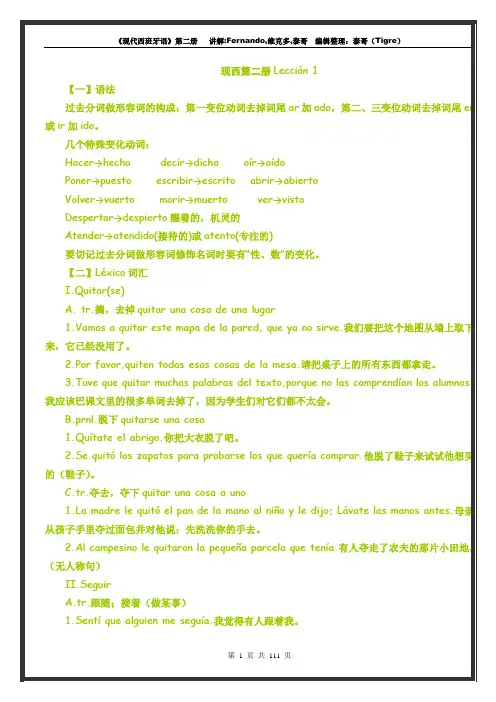
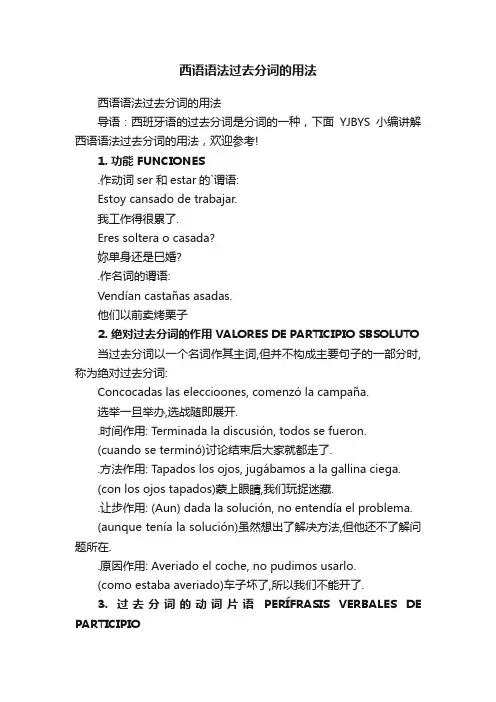
西语语法过去分词的用法西语语法过去分词的用法导语:西班牙语的过去分词是分词的一种,下面YJBYS小编讲解西语语法过去分词的用法,欢迎参考!1. 功能 FUNCIONES.作动词ser 和estar的`谓语:Estoy cansado de trabajar.我工作得很累了.Eres soltera o casada?妳单身还是巳婚?.作名词的谓语:Vendían castañas asadas.他们以前卖烤栗子2. 绝对过去分词的作用 VALORES DE PARTICIPIO SBSOLUTO当过去分词以一个名词作其主词,但并不构成主要句子的一部分时,称为绝对过去分词:Concocadas las eleccioones, comenzó la campaña.选举一旦举办,选战随即展开..时间作用: Terminada la discusión, todos se fueron.(cuando se terminó)讨论结束后大家就都走了..方法作用: Tapados los ojos, jugábamos a la gallina ciega.(con los ojos tapados)蒙上眼睛,我们玩捉迷藏..让步作用: (Aun) dada la solución, no entendía el problema.(aunque tenía la solución)虽然想出了解决方法,但他还不了解问题所在..原因作用: Averiado el coche, no pudimos usarlo.(como estaba averiado)车子坏了,所以我们不能开了.3. 过去分词的动词片语PERÍFRASIS VERBALES DE PARTICIPIO过去分词的动词片语是由一个助动词及一个过去分词组合而成:Andar+paticipio 表达一个持续性的动性:No sé lo que te pasa, andas muy perocupado.我不知道你怎麽了, 你很担心的样子.Dar por +participio 表达一个认定巳结束的动作:Doy por concluida la discusión.我结束讨论.Dejar+ participio 表达前一个动词所造成的结果:El trabajo te ha dejado agotado.这工作把你累坏了.Estar+ participio 表达一个巳实现且或可继续的动作:Estoy harto.我吃饱了.Ir+ participio 表强调坚持:Siempre va muy bien vestida.他总是穿得很讲究.Llevar+ participio =Haber+ participio con o sin sentido repetitivo:Llevo enviadas muchas demandas de empleo.我寄了得求职信.Llevo puestos los zapatos nuevos.我穿着新鞋.Quedar+ participio 表达巳结束的动作.:El problema ya quedó resuelto.问题巳解决了.Quedarse+ participio 结果Se quedó pasmado.他呆住了.Tener+ participio 有多重含义: 结束,持续,重複,累积:Tengo pensado cambiar de piso.我常想搬家Te tengo dicho que no hagas ruido.我不断告诉你别製造噪音.Tengo escritas muchas cartas. 我写了很多信.。
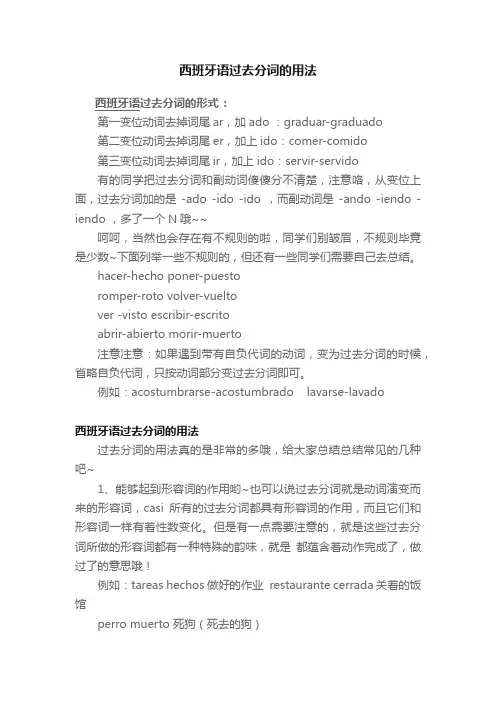
西班牙语过去分词的用法西班牙语过去分词的形式:第一变位动词去掉词尾ar,加ado :graduar-graduado第二变位动词去掉词尾er,加上ido:comer-comido第三变位动词去掉词尾ir,加上ido:servir-servido有的同学把过去分词和副动词傻傻分不清楚,注意咯,从变位上面,过去分词加的是-ado -ido -ido ,而副动词是-ando -iendo -iendo ,多了一个N哦~~呵呵,当然也会存在有不规则的啦,同学们别皱眉,不规则毕竟是少数~下面列举一些不规则的,但还有一些同学们需要自己去总结。
hacer-hecho poner-puestoromper-roto volver-vueltover -visto escribir-escritoabrir-abierto morir-muerto注意注意:如果遇到带有自负代词的动词,变为过去分词的时候,省略自负代词,只按动词部分变过去分词即可。
例如:acostumbrarse-acostumbrado lavarse-lavado西班牙语过去分词的用法过去分词的用法真的是非常的多哦,给大家总结总结常见的几种吧~1、能够起到形容词的作用哟~也可以说过去分词就是动词演变而来的形容词,casi所有的过去分词都具有形容词的作用,而且它们和形容词一样有着性数变化。
但是有一点需要注意的,就是这些过去分词所做的形容词都有一种特殊的韵味,就是都蕴含着动作完成了,做过了的意思哦!例如:tareas hechos 做好的作业 restaurante cerrada 关着的饭馆perro muerto 死狗(死去的狗)2、及物动词的过去分词和系动词ser合用,能够构成被动语态,注意必须得是及物动词的过去分词,如果不及物动词,比如,llorar哭,它是不及物的,我们能够说谁谁谁被哭吗?这个在逻辑上是行不通的,所以大家一定要注意是及物动词的过去分词。
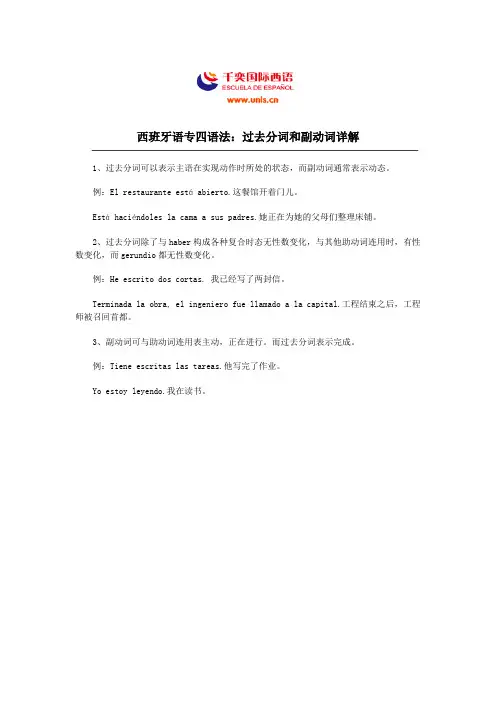
西班牙语专四语法:过去分词和副动词详解
1、过去分词可以表示主语在实现动作时所处的状态,而副动词通常表示动态。
例:El restaurante está abierto.这餐馆开着门儿。
Está haciéndoles la cama a sus padres.她正在为她的父母们整理床铺。
2、过去分词除了与haber构成各种复合时态无性数变化,与其他助动词连用时,有性数变化,而gerundio都无性数变化。
例:He escrito dos cortas. 我已经写了两封信。
Terminada la obra, el ingeniero fue llamado a la capital.工程结束之后,工程师被召回首都。
3、副动词可与助动词连用表主动,正在进行。
而过去分词表示完成。
例:Tiene escritas las tareas.他写完了作业。
Yo estoy leyendo.我在读书。
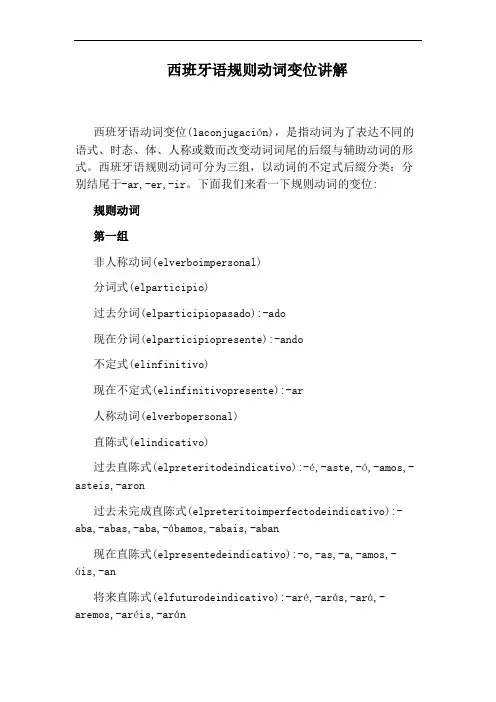
西班牙语规则动词变位讲解西班牙语动词变位(laconjugación),是指动词为了表达不同的语式、时态、体、人称或数而改变动词词尾的后缀与辅助动词的形式。
西班牙语规则动词可分为三组,以动词的不定式后缀分类:分别结尾于-ar,-er,-ir。
下面我们来看一下规则动词的变位:规则动词第一组非人称动词(elverboimpersonal)分词式(elparticipio)过去分词(elparticipiopasado):-ado现在分词(elparticipiopresente):-ando不定式(elinfinitivo)现在不定式(elinfinitivopresente):-ar人称动词(elverbopersonal)直陈式(elindicativo)过去直陈式(elpreteritodeindicativo):-é,-aste,-ó,-amos,-asteis,-aron过去未完成直陈式(elpreteritoimperfectodeindicativo):-aba,-abas,-aba,-ábamos,-abais,-aban现在直陈式(elpresentedeindicativo):-o,-as,-a,-amos,-áis,-an将来直陈式(elfuturodeindicativo):-aré,-arás,-ará,-aremos,-aréis,-arán条件式(elcondicional)现在条件式(elpresentedecondicional):-aría,-arías,-aría,-aríamos,-aríais,-arían虚拟式(elsubjuntivo)过去虚拟一式(elimperfectodesubjuntivo):-ara,-aras,-ara,-áramos,-arais,-aran过去虚拟二式(elimperfectodesubjuntivo):-ase,-ases,-ase,-ásemos,-aseis,-asen现在虚拟式(elpresentedesubjuntivo):-e,-es,-e,-emos,-éis,-en命令式(elimperativo)现在命令式(elpresentedeimperativo):无,-a,-e,-emos,-ad,-en第二组非人称动词(elverboimpersonal)分词式(elparticipio)过去分词(elparticipiopasado):-ido现在分词(elparticipiopresente):-iendo不定式(elinfinitivo)现在不定式(elinfinitivopresente):-er人称动词(elverbopersonal)直陈式(elindicativo)过去直陈式(elpreteritodeindicativo):-í,-iste,-ió,-imos,-isteis,-ieron过去未完成直陈式(elpreteritoimperfectodeindicativo):-ía,-ías,-ía,-íamos,-íais,-ían现在直陈式(elpresentedeindicativo):-o,-es,-e,-emos,-éis,-en将来直陈式(elfuturodeindicativo):-eré,-erás,-erá,-eremos,-eréis,-erán条件式(elcondicional)现在条件式(elpresentedecondicional):-ería,-erías,-ería,-eríamos,-eríais,-erían虚拟式(elsubjuntivo)过去虚拟一式(elimperfectodesubjuntivo):-iera,-ieras,-iera,-iéramos,-ierais,-ieran过去虚拟二式(elimperfectodesubjuntivo):-iese,-ieses,-iese,-iésemos,-ieseis,-iesen现在虚拟式(elpresentedesubjuntivo):-a,-as,-a,-amos,-áis,-an命令式(elimperativo)现在命令式(elpresentedeimperativo):无,-e,-a,-amos,-ed,-an第三组非人称动词(elverboimpersonal)分词式(elparticipio)过去分词(elparticipiopasado):-ido现在分词(elparticipiopresente):-iendo不定式(elinfinitivo)现在不定式(elinfinitivopresente):-ir人称动词(elverbopersonal)直陈式(elindicativo)过去直陈式(elpreteritodeindicativo):-í,-iste,-ió,-imos,-isteis,-ieron过去未完成直陈式(elpreteritoimperfectodeindicativo):-ía,-ías,-ía,-íamos,-íais,-ían现在直陈式(elpresentedeindicativo):-o,-es,-e,-imos,-ís,-en将来直陈式(elfuturodeindicativo):-iré,-irás,-irá,-iremos,-iréis,-irán条件式(elcondicional)现在条件式(elpresentedecondicional):-iría,-irías,-iría,-iríamos,-iríais,-irían虚拟式(elsubjuntivo)过去虚拟一式(elimperfectodesubjuntivo):-iera,-ieras,-iera,-iéramos,-ierais,-ieran过去虚拟二式(elimperfectodesubjuntivo):-iese,-ieses,-iese,-iésemos,-ieseis,-iesen现在虚拟式(elpresentedesubjuntivo):-a,-as,-a,-amos,-áis,-an命令式(elimperativo)现在命令式(elpresentedeimperativo):无,-e,-a,-amos,-id,-an.。
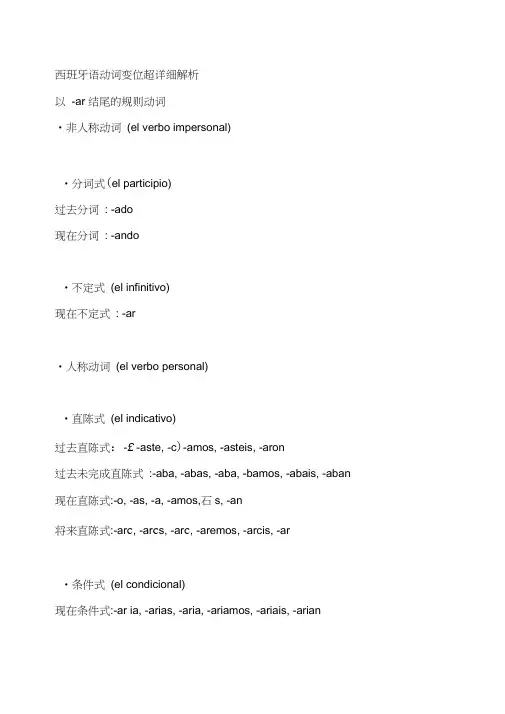
西班牙语动词变位超详细解析以-ar 结尾的规则动词•非人称动词(el verbo impersonal)•分词式(el participio)过去分词: -ado现在分词: -ando•不定式(el infinitivo)现在不定式: -ar•人称动词(el verbo personal)•直陈式(el indicativo)过去直陈式:-£ -aste, -c)-amos, -asteis, -aron过去未完成直陈式:-aba, -abas, -aba, -bamos, -abais, -aban 现在直陈式:-o, -as, -a, -amos,石s, -an将来直陈式:-ar c, -ar c s, -ar c, -aremos, -arcis, -ar•条件式(el condicional)现在条件式:-ar ia, -arias, -aria, -ariamos, -ariais, -arian•虚拟式(el subjuntivo)过去虚拟一式:-ara, -aras, -ara, -ramos, -arais, -aran过去虚拟二式:-ase, -ases, -ase,dBemos, -aseis, -asen 现在虚拟式:-e, -es, -e, -emos, -is, -en•命令式(el imperativo)现在命令式:无, -a, -e, -emos, -ad, -en以-er 结尾的规则动词•非人称动词(el verbo impersonal)•分词式(el participio)过去分词: -ido现在分词: -iendo•不定式(el infinitivo)现在不定式: -er•人称动词(el verbo personal)•直陈式(el indicativo)过去直陈式-^, -iste, -i q-imos, -isteis, -ieron过去未完成直陈式:-ia, - ias, -ia, - B mos, - lais, - B n现在直陈式:-o, -es, -e, -emos, -is, -en将来直陈式:-er - -erds, -er q-eremos, -e—s, -er dn•条件式(el con dici on al)现在条件式:-er ia, -erias, -eria, -eriamos, -eriais, -erian•虚拟式(el subjuntivo)过去虚拟一式: -iera, -ieras, -iera, -i-ramos, -ierais, -ieran 过去虚拟二式: -iese, -ieses, -iese, --isemos, -ieseis, -iesen 现在虚拟式: -a, -as, -a, -amos, d-is, -an•命令式(el imperativo)现在命令式: 无, -e, -a, -amos, -ed, -an以-ir结尾的规则动词•非人称动词(el verbo impersonal)•分词式(el participio)过去分词: -ido现在分词: -iendo不定式(el infinitivo)现在不定式: -ir•人称动词(el verbo personal)•直陈式(el indicativo)过去直陈式:-1,-iste, -i c, -imos, -isteis, -ieron过去未完成直陈式:-ia, - ias, -ia, - a mos, - iais, - B n现在直陈式:-o, -es, -e, -imos, -is, -en将来直陈式:-ir 匕-ir ds, -ir a, -iremos, -ir cis, -ir 6•条件式(el condicional)现在条件式:-ir ia, -ir ias, -ir ia, -ir iamos, -ir iais, -ir ian•虚拟式(el subjuntivo)过去虚拟一式: -iera, -ieras, -iera, -i c ramos, -ierais, -ieran 过去虚拟二式: -iese, -ieses, -iese, -c isemos, -ieseis, -iesen 现在虚拟式: -a, -as, -a, -amos, a-is, -an•命令式(el imperativo)现在命令式: 无, -e, -a, -amos, -id, -an不规则动词ser•非人称动词(el verbo impersonal)•分词式(el participio)过去分词: sido现在分词: siendo•不定式(el infinitivo)现在不定式: ser•人称动词(el verbo personal)•直陈式(el indicativo)过去直陈式: fui, fuiste, fue, fuimos, fuisteis, fueron过去未完成直陈式:era, eras, era, &amos, erais, eran 现在直陈式: soy, eres, es, somos, sois, son将来直陈式:ser^serds, sera, seremos, seris, ser®•条件式(el condicional)现在条件式:seria, serias, seria, seriamos, sersais, serian虚拟式(el subjuntivo) 过去虚拟一式:fuera, fueras, fuera, furamos, fuerais, fueran过去虚拟二式:fuese, fueses, fuese, fusemos, fueseis, fuesen 现在虚拟式:sea, seas, sea, seamos, <s&, sean•命令式(el imperativo)现在命令式: 无, s r,sea, seamos, sed, sean不规则动词tener•非人称动词(el verbo impersonal)•分词式(el participio)过去分词: tenido现在分词: teniendo•不定式(el infinitivo)现在不定式: tener•人称动词(el verbo personal)•直陈式(el indicativo)过去直陈式: tuve, tuviste, tuvo, tuvimos, tuvisteis, tuvieron过去未完成直陈式:ten ia, tenias, tenia, teniamos, ten^is, ten ian 现在直陈式:ten go, tie nes, tie ne, ten emos, te A s, tie nen将来直陈式:ten dr^te ndr$, ten dr a ten dremos, ten d A s, ten dr®•条件式(el con dici on al)现在条件式:tendr ia, ten drias, ten dria, ten dr samos, ten driais, ten dr ia n•虚拟式(el subjuntivo)过去虚拟一式:tuviera, tuvieras, tuviera, tuvi c ramos, tuvierais, tuvieran 过去虚拟二式: tuviese, tuvieses, tuviese, tuvisemos, tuvieseis, tuviesen 现在虚拟式: tenga, tengas, tenga, tengamos, ten a gis, tengan•命令式(el imperativo)现在命令式: 无, ten, tenga, tengamos, tened, tengan不规则动词estar•非人称动词(el verbo impersonal)•分词式(el participio)过去分词: estado现在分词: estando•不定式(el infinitivo)现在不定式: estar•人称动词(el verbo personal)•直陈式(el indicativo)过去直陈式: estuve, estuviste, estuvo, estuvimos, estuvisteis, estuvieron 过去未完成直陈式:estaba, estabas, estaba, ebamos, estabais, estaban 现在直陈式:estoy, estSs, esta, estamos, estis, est®将来直陈式:estar g estards, estar q estaremos, estaris, estardn•条件式(el condicional)现在条件式:estaria, estarias, estarfa, estariamos, estariais, estarian•虚拟式(el subjuntivo)过去虚拟一式: estuviera, estuvieras, estuviera, estu r viramos, estuvierais, estuvieran过去虚拟二式: estuviese, estuvieses, estuviese, estu r vsiemos, estuvieseis, estuviesen现在虚拟式: est r, est r s, est r,estemos, es r tis, est r n•命令式(el imperativo)现在命令式: 无, est a,est r, estemos, estad, es r tn。
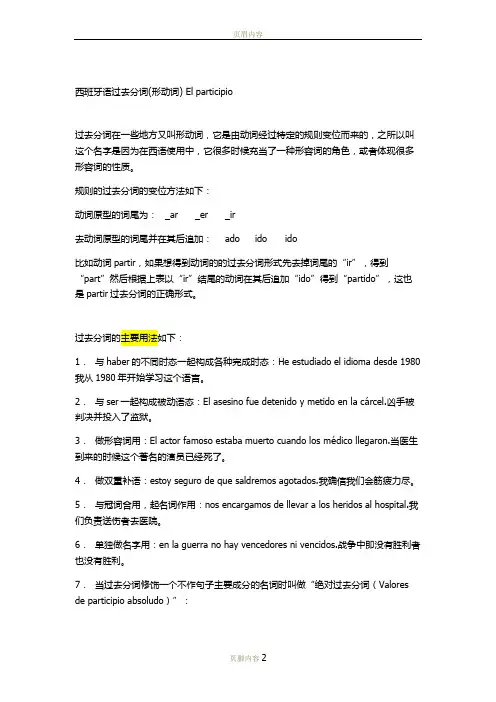
西班牙语过去分词(形动词) El participio过去分词在一些地方又叫形动词,它是由动词经过特定的规则变位而来的,之所以叫这个名字是因为在西语使用中,它很多时候充当了一种形容词的角色,或者体现很多形容词的性质。
规则的过去分词的变位方法如下:动词原型的词尾为:_ar _er _ir去动词原型的词尾并在其后追加:ado ido ido比如动词partir,如果想得到动词的的过去分词形式先去掉词尾的“ir”,得到“part”然后根据上表以“ir”结尾的动词在其后追加“ido”得到“partido”,这也是partir过去分词的正确形式。
过去分词的主要用法如下:1.与haber的不同时态一起构成各种完成时态:He estudiado el idioma desde 1980我从1980年开始学习这个语言。
2.与ser一起构成被动语态:El asesino fue detenido y metido en la cárcel.凶手被判决并投入了监狱。
3.做形容词用:El actor famoso estaba muerto cuando los médico llegaron.当医生到来的时候这个著名的演员已经死了。
4.做双重补语:estoy seguro de que saldremos agotados.我确信我们会筋疲力尽。
5.与冠词合用,起名词作用:nos encargamos de llevar a los heridos al hospital.我们负责送伤者去医院。
6.单独做名字用:en la guerra no hay vencedores ni vencidos.战争中即没有胜利者也没有胜利。
7.当过去分词修饰一个不作句子主要成分的名词时叫做“绝对过去分词(Valores de participio absoludo)”:条件作用Concocadas las elecciones, comenzó la campaña.选举一旦举办,战争随即展开。
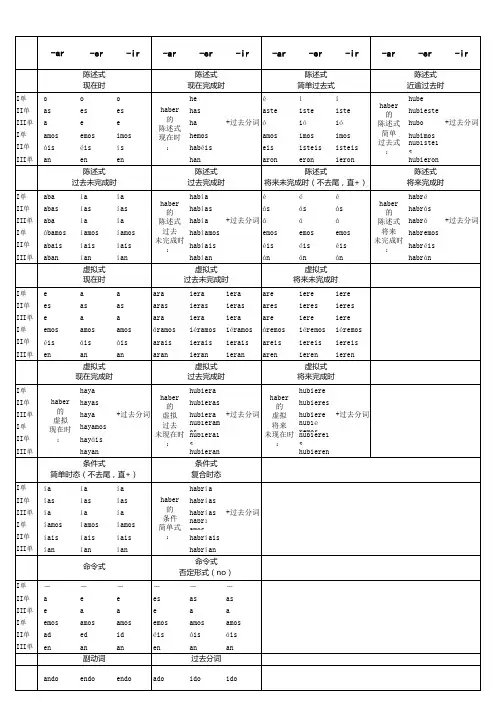
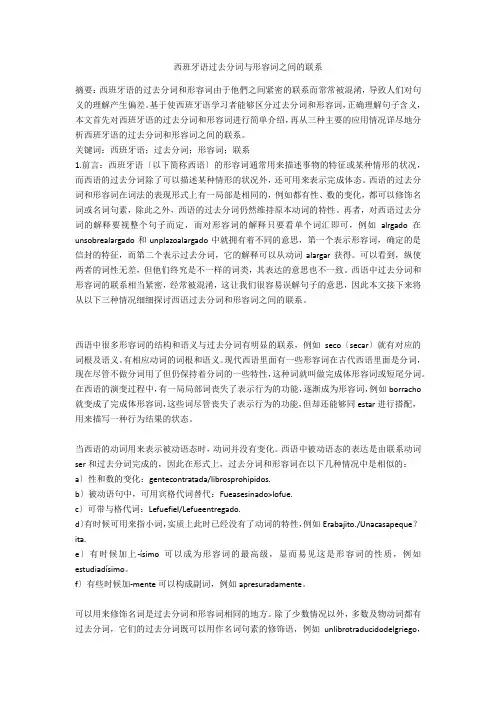
西班牙语过去分词与形容词之间的联系摘要:西班牙语的过去分词和形容词由于他們之间紧密的联系而常常被混淆,导致人们对句义的理解产生偏差。
基于使西班牙语学习者能够区分过去分词和形容词,正确理解句子含义,本文首先对西班牙语的过去分词和形容词进行简单介绍,再从三种主要的应用情况详尽地分析西班牙语的过去分词和形容词之间的联系。
关键词:西班牙语;过去分词;形容词;联系1.前言:西班牙语〔以下简称西语〕的形容词通常用来描述事物的特征或某种情形的状况,而西语的过去分词除了可以描述某种情形的状况外,还可用来表示完成体态。
西语的过去分词和形容词在词法的表现形式上有一局部是相同的,例如都有性、数的变化,都可以修饰名词或名词句素,除此之外,西语的过去分词仍然维持原本动词的特性。
再者,对西语过去分词的解释要视整个句子而定,而对形容词的解释只要看单个词汇即可,例如alrgado在unsobrealargado和unplazoalargado中就拥有着不同的意思,第一个表示形容词,确定的是信封的特征,而第二个表示过去分词,它的解释可以从动词alargar获得。
可以看到,纵使两者的词性无差,但他们终究是不一样的词类,其表达的意思也不一致。
西语中过去分词和形容词的联系相当紧密,经常被混淆,这让我们很容易误解句子的意思,因此本文接下来将从以下三种情况细细探讨西语过去分词和形容词之间的联系。
西语中很多形容词的结构和语义与过去分词有明显的联系,例如seco〔secar〕就有对应的词根及语义。
有相应动词的词根和语义。
现代西语里面有一些形容词在古代西语里面是分词,现在尽管不做分词用了但仍保持着分词的一些特性,这种词就叫做完成体形容词或短尾分词。
在西语的演变过程中,有一局局部词丧失了表示行为的功能,逐渐成为形容词,例如borracho 就变成了完成体形容词,这些词尽管丧失了表示行为的功能,但却还能够同estar进行搭配,用来描写一种行为结果的状态。
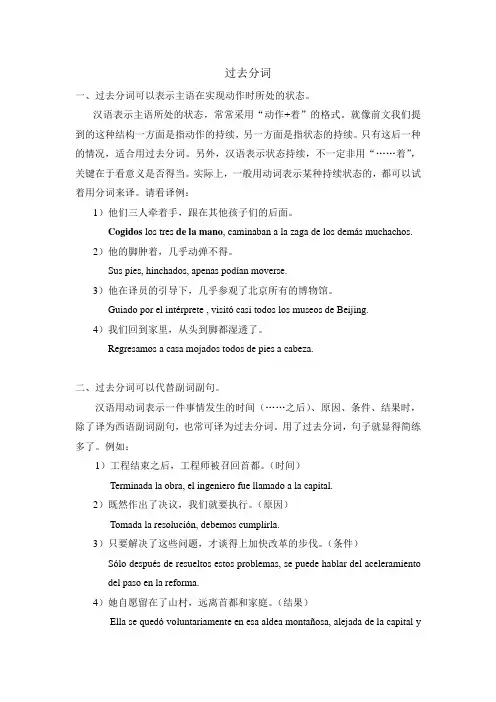
过去分词一、过去分词可以表示主语在实现动作时所处的状态。
汉语表示主语所处的状态,常常采用“动作+着”的格式。
就像前文我们提到的这种结构一方面是指动作的持续,另一方面是指状态的持续。
只有这后一种的情况,适合用过去分词。
另外,汉语表示状态持续,不一定非用“……着”,关键在于看意义是否得当。
实际上,一般用动词表示某种持续状态的,都可以试着用分词来译。
请看译例:1)他们三人牵着手,跟在其他孩子们的后面。
Cogidos los tres de la mano, caminaban a la zaga de los demás muchachos.2)他的脚肿着,几乎动弹不得。
Sus pies, hinchados, apenas podían moverse.3)他在译员的引导下,几乎参观了北京所有的博物馆。
Guiado por el intérprete , visitó casi todos los museos de Beijing.4)我们回到家里,从头到脚都湿透了。
Regresamos a casa mojados todos de pies a cabeza.二、过去分词可以代替副词副句。
汉语用动词表示一件事情发生的时间(……之后)、原因、条件、结果时,除了译为西语副词副句,也常可译为过去分词。
用了过去分词,句子就显得简练多了。
例如:1)工程结束之后,工程师被召回首都。
(时间)Terminada la obra, el ingeniero fue llamado a la capital.2)既然作出了决议,我们就要执行。
(原因)Tomada la resolución, debemos cumplirla.3)只要解决了这些问题,才谈得上加快改革的步伐。
(条件)Sólo después de resueltos estos problemas, se puede hablar del aceleramiento del paso en la reforma.4)她自愿留在了山村,远离首都和家庭。
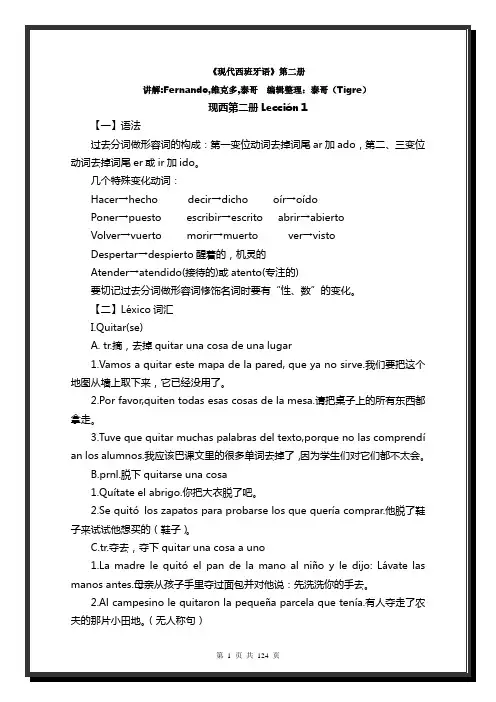
《现代西班牙语》第二册讲解:Fernando,维克多,泰哥编辑整理:泰哥(Tigre)现西第二册Lección 1【一】语法过去分词做形容词的构成:第一变位动词去掉词尾ar加ado,第二、三变位动词去掉词尾er或ir加ido。
几个特殊变化动词:Hacer→hecho decir→dicho oír→oídoPoner→puesto escribir→escrito abrir→abiertoVolver→vuerto morir→muerto ver→vistoDespertar→despierto醒着的,机灵的Atender→atendido(接待的)或atento(专注的)要切记过去分词做形容词修饰名词时要有“性、数”的变化。
【二】Léxico词汇I.Quitar(se)A. tr.摘,去掉quitar una cosa de una lugar1.Vamos a quitar este mapa de la pared, que ya no sirve.我们要把这个地图从墙上取下来,它已经没用了。
2.Por favor,quiten todas esas cosas de la mesa.请把桌子上的所有东西都拿走。
3.Tuve que quitar muchas palabras del texto,porque no las comprendían los alumnos.我应该巴课文里的很多单词去掉了,因为学生们对它们都不太会。
B.prnl.脱下quitarse una cosa1.Quítate el abrigo.你把大衣脱了吧。
2.Se quitólos zapatos para probarse los que quería comprar.他脱了鞋子来试试他想买的(鞋子)。
C.tr.夺去,夺下quitar una cosa a uno madre le quitóel pan de la mano al niño y le dijo: Lávate las manos antes.母亲从孩子手里夺过面包并对他说:先洗洗你的手去。
西语过去分词的用法
西语中的过去分词(participio)是一个形容词形式,通常以-ado或-ido结尾。
它用来描述动作或状态的完成或被完成。
以下是一些过去分词的用法。
1. 形容词用法
过去分词可用作形容词,表示一个已经完成或已经发生的动作或状态。
例如:
- El coche está limpiado. (车子被清洗了。
)
- La carta está escrita a mano. (信是手写的。
)
过去分词可以与词组estar或ser连用,生成现在完成时或被动语态。
例如:
2. 过去完成时
过去完成时(pretérito perfecto compuesto)是指动作在过去发生并已经完成,常常与“hace (时间)”或“desde (时间)”连用。
过去分词被用作主要动词的形式。
例如:
- Había escrito la carta antes de salir. (在出门前我已经写了这封信。
)
- Se había perdido la llave. (钥匙丢了。
)
- Fue cocida con cebolla y ajo. (它用洋葱和大蒜煮过。
)。
【西班牙语语法讲解】过去分词过去分词在一些地方又叫形动词,它是由动词经过特定的规则变位而来的,之所以叫这个名字是因为在西语使用中,它很多时候充当了一种形容词的角色,或者体现很多形容词的性质。
规则的过去分词的变位方法如下:动词原型的词尾为:_ar_er_ir去动词原型的词尾并在其后追加:adoidoido比如动词partir,如果想得到动词的的过去分词形式先去掉词尾的“ir”,得到“part”然后根据上表以“ir”结尾的动词在其后追加“ido”得到“partido”,这也是partir过去分词的正确形式。
过去分词的主要用法如下:1.与haber的不同时态一起构成各种完成时态:He estudiado la idiomadesde 1980我从1980年开始学习这个语言。
2.与ser一起构成被动语态:El asesinofuedetenido y metido en la cárcel.凶手被判决并投入了监狱。
3.做形容词用:El actor famosoestabamuertocuando los médicollegaron.当医生到来的时候这个著名的演员已经死了。
4.做双重补语:estoyseguro de quesaldremosagotados.我确信我们会筋疲力尽。
5.与冠词合用,起名词作用:nosencargamos de llevar a los heridos al hospital.我们负责送伤者去医院。
6.单独做名字用:en la guerra no hay vencedoresnivencidos.战争中即没有胜利者也没有胜利。
7.当过去分词修饰一个不作句子主要成分的名词时叫做“绝对过去分词(Valores de participioabsoludo)”:条件作用Concocadaslaselecciones, comenzó la campaña.选举一旦举办,战争随即展开。
1金河权西班牙语简明语法讲座系列14第5-30课《动词过去分词》及其用法大全1、过去分词(Participio)概述—○➊过去分词是由动词演变过来的,既可用做形容词,又可用做动词。
○➋过去分词的形容词用法,应与被修饰的名词“性、数”要一致。
○➌及物动词的过去分词含有被动意义,而不及物动词的过去分词含有主动意义。
○➍过去分词,与助动词连用构成复合时态,并无“性、数”变化。
注:过去分词,因很多场合充当形容词的角色、体现形容词性质,故也称之为形动词。
2、构成—*1.*2.不规则动词过去分词,词尾有三种: “ -to、-so、-che ”注:大部分动词过去分词是规则的,也有些是不规则的。
常见的不规则动词的过去分词:原形动词过去分词原形动词过去分词volver(返回) vuelto satisfacer(满意) satisfechoabrir(打开) abierto cubrir(盖) cubiertover(看见) visto morir(死) muertohacer(做) echo poner(放) puestoimprimir(印刷) impreso romper(破坏) roto[或rompito]freir(煎) frito[freído] disolver(解散) disueltoescribir(写) escrito prender(捕) preso「prendido」decir(说) dicho resolver(解决) resueltoprobeer(准备、供应) provisto[proveído] descubrir(发现) descubierto*3.具有两种过去分词的动词:[-to] 形;原形动词规则的不规则的abstraer(使抽象) abstraído abstractoatender(顾及) atendido atentoafligir(折磨) afligido aflictobendecir(赞美)bendecido benditocorregir(修正)corregirdo correctoconfundir(混淆) confundido cofuso2 despertar(唤醒) despertado despiertoelegir(选择) elegido electoenjugar(弄干)enjugado enjutoeximir(免除)eximido exentoextinguir(熄灭)extinguido extintohartar(使饱餐) hartado hartoinjertar(嫁接)injertado injertoinsertar(便插入)insertado insertojuntar(接合)juntado juntomaldecir(诅咒) maldecido malditomanifestar(声明) manifestado manifiestonacer(出生)nacido natoproveer(供应) proveído provistosepultar(埋葬)sepultado sepultosoltar(解开) sotaldo sueltosujetar(征服)sujetado sujetotorcer(扭曲)torcido tuerto[-so] 形;原形动词规则的不规则的circuncidar(环绕)circuncidado circuncisocompeler(强迫)compelido compulsoconcluir(下结论) concluido conclusoconfesar(承认) confesado confesoconfundir(弄混)confundido confusocontundir(殴打)contundido contusoconvertir(改变)convertido conversodifundir(传播) difundido difusoimprimir(印刷) imprimido impresosuspender(暂停) suspendido suspenso3、动词过去分词用法—过去分词;○1具有“过去和主、被动”性质,○2伴随助动词“haber、ser”起动词作用,○3伴随其它动词起形容词作用。
西班牙语过去分词(形动词) El participio过去分词在一些地方又叫形动词,它是由动词经过特定的规则变位而来的,之所以叫这个名字是因为在西语使用中,它很多时候充当了一种形容词的角色,或者体现很多形容词的性质。
规则的过去分词的变位方法如下:动词原型的词尾为:_ar _er _ir去动词原型的词尾并在其后追加:ado ido ido比如动词partir,如果想得到动词的的过去分词形式先去掉词尾的“ir”,得到“part”然后根据上表以“ir”结尾的动词在其后追加“ido”得到“partido”,这也是partir过去分词的正确形式。
过去分词的主要用法如下:1.与haber的不同时态一起构成各种完成时态:He estudiado el idioma desde 1980我从1980年开始学习这个语言。
2.与ser一起构成被动语态:El asesino fue detenido y metido en la cárcel.凶手被判决并投入了监狱。
3.做形容词用:El actor famoso estaba muerto cuando los médico llegaron.当医生到来的时候这个著名的演员已经死了。
4.做双重补语:estoy seguro de que saldremos agotados.我确信我们会筋疲力尽。
5.与冠词合用,起名词作用:nos encargamos de llevar a los heridos al hospital.我们负责送伤者去医院。
6.单独做名字用:en la guerra no hay vencedores ni vencidos.战争中即没有胜利者也没有胜利。
7.当过去分词修饰一个不作句子主要成分的名词时叫做“绝对过去分词(Valores de participio absoludo)”:条件作用Concocadas las elecciones, comenzó la campaña.选举一旦举办,战争随即展开。
西班牙语语法过去分词El participio pasadoI. Formación de los participios pasados regulares(规则过去分词的形式)-AR-ado-ER-IR-ido例 : cant-ar→ cant-adobail-ar→ bail-adocom-er→ com-idos-er→ s-idodorm-ir→ dorm-idoir→idoEn algunos casos, en los verbos en -ER e -IR, cuando la raíz del verbo termina en vocal fuerte, será necesario acentuar la I de la terminaci ón(在某些情况下,在以-ER和–IR结尾的动词中,如果词根的结尾是重元音的话,那么就有必要在词尾的I上面加重音。
)Ejs: le-er→ le-ídore-ír→ re-ídoPero no si la raíz del verbo termina en vocal débil:(如果词根是以弱元音结尾的,则不用加重音。
)Ejs: constru-ir→ constru-idodistribu-ir→ distribu-idoII. Participios pasados irregulars(不规则过去分词)VERBO PARTICIPIOPASADOY TAMBIÉNabrir abierto entreabrir entreabierto reabrir reabiertoabsolver absuelto disolver disuelto resolver resueltocubrir cubierto descubrir descubierto encubrir encubierto recubrir recubiertodecir dicho contradecir contradicho predecir predicho pero: bendecir bendecido y: maldecir maldecidoescribir escrito adscribir adscrito circunscribir circunscrito inscribir inscrito manuscribir manuscrito prescribir prescrito proscribir proscrito reinscribir reinscrito rescribir rescrito sobrescribir sobrescrito subscribir subscrito suscribir suscrito transcribir transcrito trascribir trascritohacer hecho deshacer deshecho rehacer rehecho licuefacer licuefacto rarefacer rarefacto satisfacer satisfecho tumefacer tumefactomorir muertoponer puesto anteponer antepuesto disponer dispuesto exponer expuestoimponer impuestooponer opuestoposponer pospuestoproponer propuestoreponer repuestosuperponer superpuestosuponer supuestoyuxtaponer yuxtapuesto pudrir podridoromper roto pero: corromper corrompidover visto entrever entrevisto prever previstovolver vuelto desenvolver desenvuelto devolver devuelto envolver envuelto revolver revuelto注意几点:1,过去分词可以用于完成时(现在完成时,过去完成时,将来完成时等)2,过去分词也可以当作形容词(做形容词的时候有阴阳性之分)3,过去分词可用于被动句。
西班牙语过去分词用
法
西班牙语过去分词(形动词) El participio
过去分词在一些地方又叫形动词,它是由动词经过特定的规则变位而来的,之所以叫这个名字是因为在西语使用中,它很多时候充当了一种形容词的角色,或者体现很多形容词的性质。
规则的过去分词的变位方法如下:
动词原型的词尾为:_ar _er _ir
去动词原型的词尾并在其后追加:ado ido ido
比如动词partir,如果想得到动词的的过去分词形式先去掉词尾的“ir”,得到“part”然后根据上表以“ir”结尾的动词在其后追加“ido”得到“partido”,这也是partir 过去分词的正确形式。
过去分词的主要用法如下:
1.与haber的不同时态一起构成各种完成时态:He estudiado el idioma desde 1980我从1980年开始学习这个语言。
2.与ser一起构成被动语态:El asesino fue detenido y metido en la cárcel.凶手被判决并投入了监狱。
3.做形容词用:El actor famoso estaba muerto cuando los médico llegaron.当医生到来的时候这个著名的演员已经死了。
4.做双重补语:estoy seguro de que saldremos agotados.我确信我们会筋疲力尽。
5.与冠词合用,起名词作用:nos encargamos de llevar a los heridos al hospital.我们负责送伤者去医院。
6.单独做名字用:en la guerra no hay vencedores ni vencidos.战争中即没有胜利者也没有胜利。
7.当过去分词修饰一个不作句子主要成分的名词时叫做“绝对过去分词(Valores de participio absoludo)”:
条件作用Concocadas las elecciones, comenzó la campaña.选举一旦举办,战争随即展开。
时间作用Terminada la discusión todos se fueron.讨论结束后大家都走了。
方法作用Tapados los ojos jugábamos a la gallina ciega.蒙上眼睛,我们玩捉迷藏。
让步作用(Aun) Dada la solución no entendía el problema.虽然想出了解决的办法但是还是不知道问题的所在。
原因作用Averiado el coche no pudimos usarlo.车子坏了,我们不能开了。
8.组成过去分词的动词短语,往往含有一种动作已经结束的完成时的含义构成:
助动词+过去分词所表达的意义例句
Andar+paticipio 持续性的动作No sé lo que te pasa, andas muy perocupado.我不知道你怎么了,你很担心的样子。
Dar por +participio 认定已经结束的动作Doy por concluida la discusión.我结束讨论
Dejar+ participio 前一个动词所表示的结果El trabajo te ha dejado agotado.这工作把你累坏了。
Estar+ participio 已经实现或者可以继续的动作Estoy harto.我吃饱了。
Ir+ participio 强调坚持Siempre va muy bien vestida.他总是穿的很讲究。
Llevar+ participio 非持续动作完成时态(Haber+ participio sin sentido repetitivo)
持续动作完成时态(Haber+ participio con sentido repetitivo)Llevo enviadas muchas demandas de empleo.我寄了求职信
Llevo puestos los zapatos nuevos.我穿着新鞋子
Quedar+ participio 已经结束的动作El problema ya quedó resuelto.问题已经解决了
Quedarse+ articipio 结果Se quedó pasmado.他呆住了。
Tener+ participio 结果;持续;重复;积累……等含义。
Tengo pensado cambiar de piso.我常常想搬家
Te tengo dicho que no hagas ruido.我不断告诉你不要制造噪音。
Tengo escritas muchas cartas.我写了很多信。